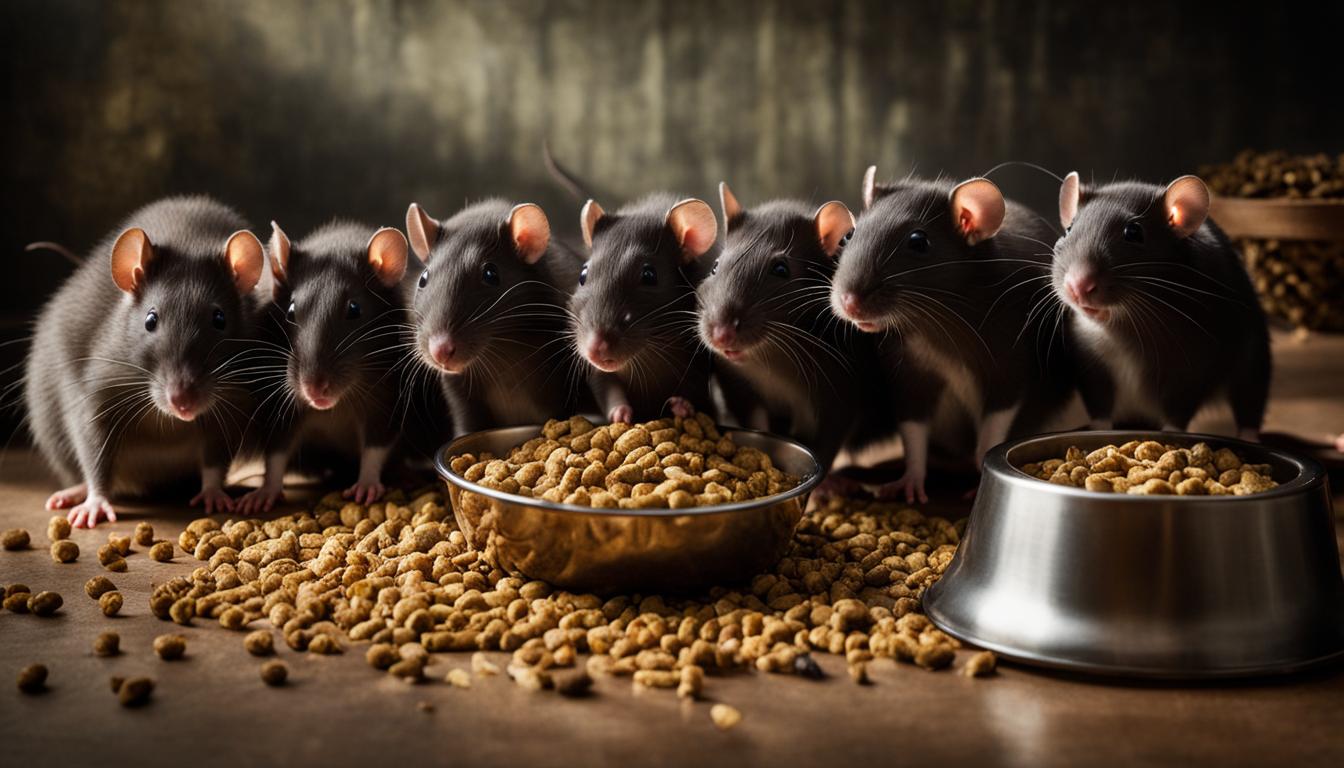Did you know that rats have a hearty appetite and will consume nearly anything they come across? This even includes dog food! With their sharp teeth and never-ending hunger, these curious animals cannot resist a delicious meal. Therefore, if you have ever questioned whether rats can consume dog food, the answer is definitely yes!
Key Takeaways:
- Rats are opportunistic feeders and will eat almost anything, including dog food.
- Allowing rats access to dog food can lead to rat infestations, the spread of diseases, and damage to your home.
- To prevent rats from accessing dog food, store it in sealed containers and maintain a clean environment.
- Professional pest control services, like Green Machine Pest Control, can help you eliminate rats and prevent future infestations.
- In addition to dog food, rats are attracted to a variety of other food sources in your home, so proper storage and hygiene practices are essential.
The Implications of Rats Eating Dog Food
When rats have access to dog food, it can lead to several problems. They can cause a rat infestation in your home, spreading diseases, causing structural damage with their gnawing, and contaminating your human food.
Rat infestation poses significant health risks. Rats are carriers of various diseases, including leptospirosis, hantavirus, and salmonellosis. These rat-borne diseases can be transmitted to humans through contact with rat urine, droppings, or bites. Additionally, rats can contaminate your human food with their fur, saliva, and feces, increasing the risk of foodborne illnesses.
Rats are prolific chewers, and their constant gnawing can wreak havoc on your property. They can damage electrical wires, insulation, pipes, and even structural elements like walls and floors. This can lead to costly repairs and compromise the integrity of your home.
Not only can rats cause physical damage, but they can also create a sense of unease and discomfort in your household. Dealing with a rat infestation can be stressful and unsettling for you and your family.
It is crucial to address rat issues promptly to prevent further damage and health risks. Implementing effective rat control measures is essential to protect your home, health, and peace of mind.
Common Rat-Borne Diseases
| Disease | Symptoms |
|---|---|
| Leptospirosis | Fever, headache, muscle aches, vomiting, jaundice |
| Hantavirus | Fever, muscle aches, shortness of breath, cough, fatigue |
| Salmonellosis | Diarrhea, abdominal cramps, fever, nausea, vomiting |
Preventing Rats from Accessing Dog Food
To effectively prevent rats from accessing dog food, it is crucial to implement proactive measures. By taking these steps, you can safeguard your pet’s food and prevent unwanted infestations in your home. Here are some key strategies to keep rats away from your dog’s meals:
- Store dog food in sealed containers: Rats have strong teeth that can easily chew through packaging. To protect your pet’s food from rat invasions, transfer it into tightly sealed containers that rats cannot penetrate. This will create a barrier between the food and the rodents, making it less accessible and less enticing.
- Maintain a clean pantry and kitchen: Rats are opportunistic feeders and will exploit any available food sources. Minimize potential temptations by keeping your pantry and kitchen clean and free from food debris. Wipe down surfaces, promptly clean up spills, and dispose of garbage properly to eliminate attractants for rats.
- Seal entry points: Prevent rats from entering your home by sealing any gaps or openings where they can gain access. Pay close attention to areas around doors, windows, vents, and utility lines, as these are common entry points for rodents. By sealing these potential entryways, you can effectively block rats from entering your living space.
- Regularly inspect and clean areas where dog food is stored: Conduct routine inspections of the areas where you store your dog’s food. Be thorough in your search for signs of rat activity, such as droppings or gnaw marks. If you notice any evidence, take immediate action by removing the contaminated food, cleaning the area, and reinforcing your rat prevention measures.
“Taking proactive steps to prevent rats from accessing dog food is vital for maintaining a rat-free environment and ensuring the health and safety of your pets.”
By following these rat prevention techniques, you can safeguard your dog’s food and create a rat-proof environment in your home. Not only will this protect your pet’s meals, but it will also minimize the risk of rat infestations, safeguard your health, and maintain the overall cleanliness of your living space.
Remember, rat prevention is a proactive endeavor that requires consistent effort and vigilance. Implement these strategies as part of your routine pet care and household maintenance practices to keep rats away and ensure a healthy, rat-free environment.
| Rat Prevention Tips | Effectiveness |
|---|---|
| Store dog food in sealed containers | Highly effective |
| Maintain a clean pantry and kitchen | Effective |
| Seal entry points | Highly effective |
| Regularly inspect and clean dog food storage areas | Effective |
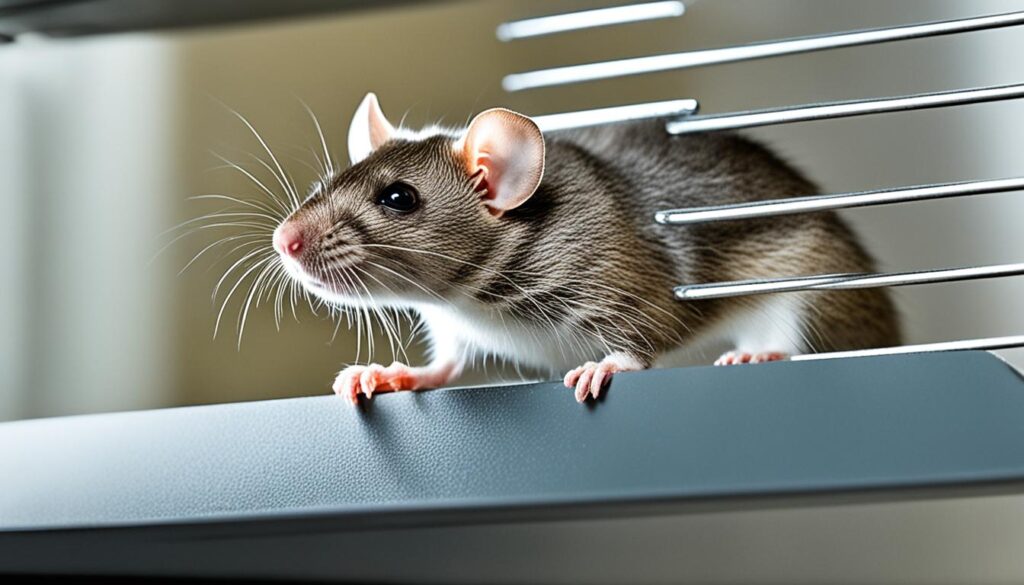
Green Machine Pest Control – Your Rat-Free Solution
When it comes to dealing with rat infestations, Green Machine Pest Control is the name you can trust. With their expertise in pest control, rat extermination, and rat removal, they offer effective solutions to help you take control of your home and eliminate these pesky rodents.
Green Machine Pest Control understands the importance of identifying potential entry points that rats may use to access your property. They provide thorough inspections to locate these vulnerable areas and develop a targeted plan to seal them off.
One of the primary strategies employed by Green Machine Pest Control is the elimination of food sources that attract rats. By removing these temptations, they can significantly reduce the likelihood of rats returning to your home.
Green Machine Pest Control takes pride in their commitment to environmentally friendly practices. Their rat removal techniques involve the use of safe and effective methods, ensuring the well-being of both your family and the ecosystem.
With Green Machine Pest Control’s rat control services, you can enjoy a rat-free environment and the peace of mind that comes with it. Say goodbye to the nuisance and potential health risks associated with rat infestations, and welcome a clean and safe living space.
Experience the expertise and professionalism of Green Machine Pest Control. Contact them today to take the first step towards a rat-free home.
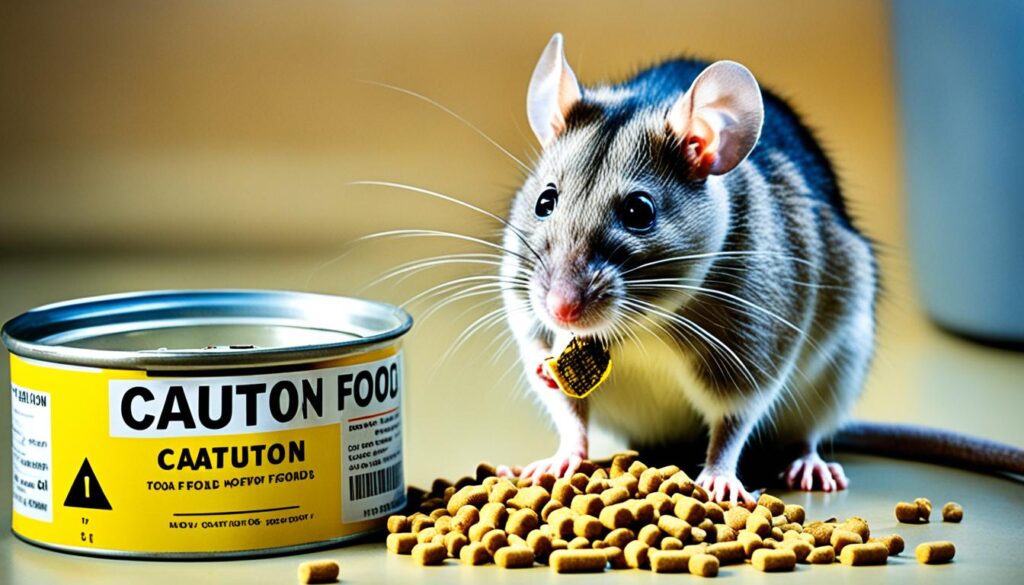
| Rat Control Services Offered by Green Machine Pest Control | Benefits |
|---|---|
| Thorough inspections to identify potential entry points | Prevent rats from accessing your property |
| Effective techniques to seal entry points | Eliminate rat access and potential infestations |
| Removal of food sources that attract rats | Reduce the likelihood of rats returning |
| Environmentally friendly practices | Safe for your family and the ecosystem |
Other Attractants for Rats in Your Home
Aside from dog food, rats are attracted to a variety of other food sources in your home. They have a keen sense of smell and can be enticed by the aroma of different items. Here are some common food sources that may attract rats:
- Plants: Rats are known to nibble on plants, especially fruits and vegetables.
- Fruits: Ripe fruits left out on countertops or in fruit bowls can be an irresistible treat for rats.
- Seeds and grains: If you store birdseed, nuts, or other grains in accessible areas, rats may see it as an open buffet.
- Meat: Rats are opportunistic feeders and won’t pass up the chance to feast on leftover meat.
- Sweet and salty snacks: Snacks like cookies, chips, and pretzels can be equally enticing for rats.
- Garbage scraps: Rats are attracted to the odors emanating from your trash, so ensure that garbage cans are tightly sealed.
- Leftovers: Rats are scavengers and will gladly help themselves to any leftovers or food spills they find.
- Food stored in cardboard boxes: Rats can easily gnaw through cardboard, so avoid keeping food in open boxes.
To reduce the risk of rat infestations, it’s essential to properly store and dispose of these items. Keep the kitchen and other areas where food is prepared or consumed clean and free of crumbs or spills. Store food in airtight containers made of metal, glass, or sturdy plastic that rats cannot chew through. Regularly empty and clean garbage cans to eliminate odors that attract rats.
“To reduce the risk of rat infestations, it’s essential to properly store and dispose of these items.”

The Secret Nesting Spots of Rats
Rats not only seek out food sources but also cozy places to nest and reproduce. These are some common nesting spots rats might find desirable:
- Attics
- Basements
- Crawl spaces
- Wall voids
- Garages
- Sheds
- Under decks or patios
- Garden sheds
These areas provide rats with shelter from the elements and protection from predators. It’s important to inspect these potential rat nesting spots regularly and seal any openings or cracks that may allow rats to enter your home. By eliminating their hiding places, you can discourage rats from establishing nests on your property.
Why Rats Are Drawn to Pet Food
Rats are naturally attracted to pet food due to its nutritional value and odor. The smell of pet food acts as an attractant, enticing rats to seek it out as a food source. This applies not only to dog food but also to other types of pet food, such as fish food, bird food, and horse food. When rats have access to pet food, it becomes a convenient and calorie-rich option for them.
To prevent rats from accessing pet food, it is crucial to store it in sealed containers that rats cannot chew through. Sealing the food helps eliminate the odor that attracts rats and makes it more difficult for them to gain access to the food. By preventing rats from reaching pet food, you can reduce the risk of a rat infestation in your home and ensure the safety of your pets.
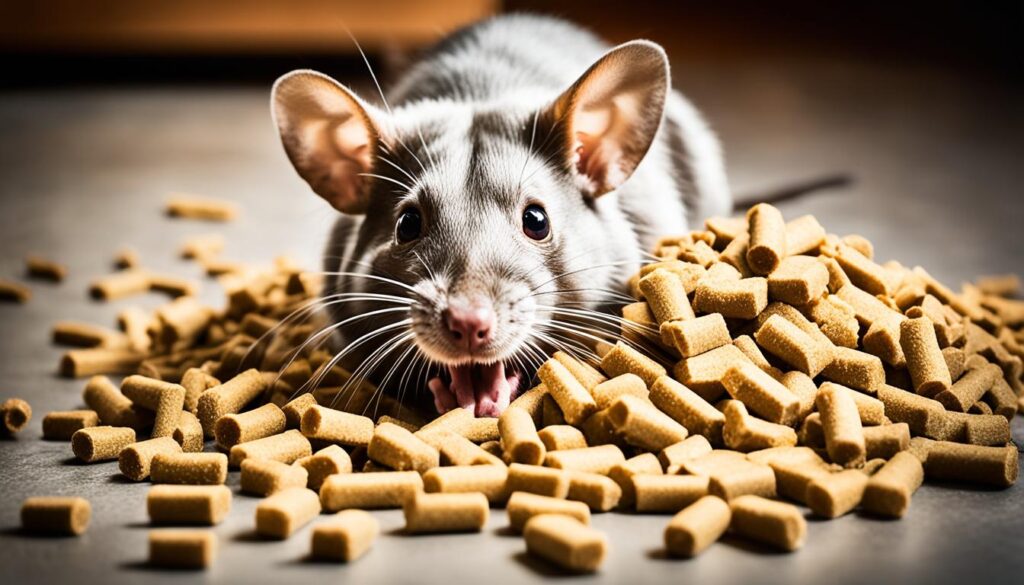
Pet Food Storage Tips:
- Transfer pet food to airtight containers immediately after opening the original packaging.
- Ensure the containers have tight-fitting lids to prevent rats from gnawing through.
- Keep pet food containers off the floor or ground to make it harder for rats to access.
- Store pet food in a cool, dry place to maintain freshness and discourage pests.
Pet food should never be left out overnight, as this can attract rats and other pests. It’s important to establish a routine of feeding your pets specific amounts at designated meal times and promptly remove any uneaten food.
Preventing rat access to pet food is an essential step in rat prevention. By taking the necessary measures to store pet food securely, you can help reduce the risk of rat infestation and ensure the health and well-being of your furry companions.
| Pet Food Attractants | Preventing Rat Access to Pet Food |
|---|---|
| – Nutritional value – Strong odor |
– Store pet food in sealed containers – Use airtight containers – Keep pet food off the ground – Remove uneaten food |
The Dangers of Rat Infestations
Rat infestations can pose serious dangers to both your health and your property. These pesky rodents are not just a nuisance; they can also carry and spread various rat-borne diseases. Additionally, rats can cause structural damage to your home and contaminate your living environment, exposing you and your family to significant health risks.
One of the primary concerns when dealing with rat infestations is the potential transmission of rat-borne diseases. Rats are known carriers of diseases such as leptospirosis, histoplasmosis, and rabies. These diseases can have severe consequences for humans, causing symptoms ranging from flu-like symptoms to life-threatening conditions. It is crucial to address rat infestations promptly to minimize the risk of contracting these diseases.
Aside from the health risks posed by rat-borne diseases, rats can also cause significant structural damage to your home. These rodents have sharp incisors that allow them to gnaw through various materials, including wires, insulation, and even wood. Their continuous chewing can weaken the structural integrity of your property, leading to costly repairs and potential safety hazards.
Furthermore, rats are notorious for leaving behind droppings and urine wherever they go. These biological waste materials can contaminate surfaces, including kitchen countertops, utensils, and food items. The presence of rat feces and urine increases the risk of bacterial contamination, which can cause food poisoning and other gastrointestinal illnesses if ingested.
To highlight the dangers of rat infestations, consider the table below:
| Risks | Description |
|---|---|
| Rat-Borne Diseases | Rats can carry diseases such as leptospirosis, histoplasmosis, and rabies, posing a significant risk to human health. |
| Structural Damage | Rats’ gnawing habits can cause damage to electrical wiring, insulation, and other structural components of your home. |
| Health Risks | Rat droppings and urine can contaminate surfaces and food, leading to bacterial infections and foodborne illnesses. |
Given the potential risks associated with rat infestations, it is crucial to take immediate action to address the issue. Hiring professional pest control services, such as Green Machine Pest Control, can help you effectively eliminate rats from your property and prevent future infestations. By doing so, you can protect your health and preserve the integrity of your home.
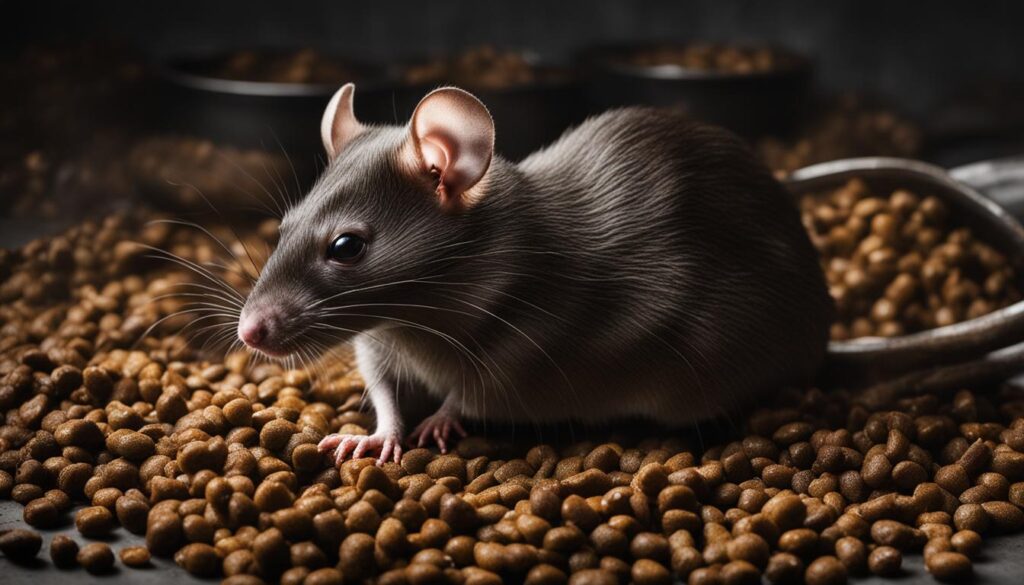
Conclusion
Rats can be attracted to dog food due to its nutritional value, but there are effective prevention measures you can take to maintain a rat-free home. By implementing these rat control techniques and following a few rat prevention tips, you can keep these unwanted visitors at bay and protect your family and property.
First and foremost, it is crucial to seal any entry points that rats could use to access your home. Inspect your property regularly for gaps, cracks, and openings and seal them using materials like caulk or wire mesh. This will help prevent rats from finding their way inside in the first place.
Another key aspect of rat prevention is eliminating potential food sources. Store your dog food and other pet foods in tightly sealed containers that rats cannot chew through. Keep your kitchen and pantry clean, ensuring that there are no crumbs or spills that could attract rats. Regularly dispose of garbage in secure outdoor containers to minimize the availability of food for these pests.
Lastly, maintaining good hygiene practices can contribute to a rat-free environment. Clean up any food spills immediately, wash dishes promptly, and sweep up any crumbs or leftover food regularly. By removing the conditions that attract rats, you can discourage their presence in your home.
If you’re struggling with a rat infestation or want professional help in implementing rat prevention measures, consider reaching out to Green Machine Pest Control. Their expert team can provide comprehensive rat control solutions tailored to your specific needs, helping you achieve a rat-free home and peace of mind.
